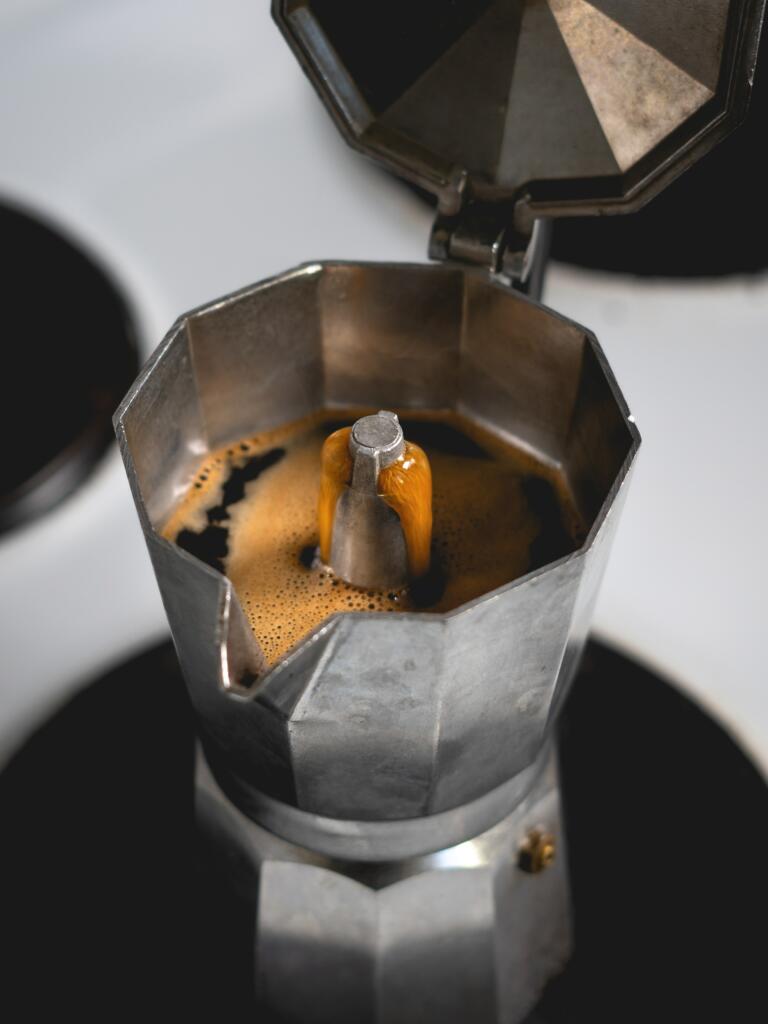What could be better than a cup of black stovetop coffee? Not much, but a lovely way to enjoy stovetop coffee is to heat milk in a saucepan and add it to the coffee. You can prepare a delicious cappuccino at home by adding hot milk to the stovetop coffee.
What exactly is a cappuccino?
A cappuccino blends strong espresso with steamed milk and foamed milk. Traditionally, all three components are used in equal proportions, but a stronger cappuccino contains a double shot of espresso. Add extra milk and foam for a softer flavor, resulting in a richer-tasting drink known as a wet cappuccino.

Cappuccino maker for the stovetop
Espresso machines, especially less expensive ones, often can’t provide enough steam pressure to froth truly creamy foam. And even a relatively cheap espresso machine will cost more than stove-top equipment.
You can get a better drink using a stand-alone milk steamer and a Moka pot. Expect to pay $40-$60 for a sturdy milk steamer and about $25 for a stove-top Moka pot.
That outlay is less than the $90 you would spend if you bought a $3 cappuccino every weekday for six weeks. And once you try cappuccino this way, you will drink a lot more than just those 30 cups.
Making espresso

Moka pots do not produce real espresso, which is produced when steam is driven through grinds at high pressure, but the brew is still powerful and robust. Make careful to choose a stainless steel Moka pot; metal will lend an unpleasant flavor to the espresso.
- Fill the bottom part of the pot with water to just under the safety valve.
- Set the basket into the pot and fill with the coffee ground to espresso fineness. Level off with a knife; don’t pack the coffee.
- Screw on the top part of the pot.
- Set the Moka pot on medium heat and let it heat until you begin to hear a gurgle, and you can see, when you open the lid, that coffee is beginning to pour into the top portion of the pot. Watch carefully and remove the pot from the heat before it starts sputtering. At the sputtering point, the liquid sprayed into the top part of the Moka pot will make the brew more bitter.
Steaming Milk
The fun part is frothing milk with the stove-top steamer. If everything goes well, the milk will double or triple in volume, and the bubbles will be small, giving the foam that silky smoothness that feels so pleasant on the taste.
A stainless steel pitcher, an instant-read thermometer, and a moist towel or dishrag are required. You may choose the fat content of the milk. Skim milk foams well, whole milk is creamy and pleasant, and half-and-half takes the drink to a new level of luxury. A breve is a half-and-half cappuccino.
- Fill the stove-top steamer with water to the level of the safety valve. Replace the basketlike piece that moderates the steam and securely screw on the top. Make sure the steam valve is closed.
- Set the stove-top steamer on high heat and leave it undisturbed as the water inside boils and steam builds. It’s a good idea to keep track of how long it takes for the steam to be strong enough, so you can set a timer for when you foam milk again.
- Add milk to the pitcher, filling no more than 1/3 full. Stick the thermometer in the milk.
- When the steam is ready, hold the pitcher so that the wand of the stove-top steamer is under the milk’s surface and gently open the steam valve.
- Listen. If the steamer’s noise is continually loud and piercing, the steam isn’t quite there yet. Close the valve, wipe the milk off the wand, and let the pot heat a bit longer.
- Steam the milk with the want just under the surface until the thermometer reads about 150 degrees F. As the temperature of the milk increases, so should its volume.
- When you’re done steaming, remove the stove-top steamer from the heat. Wipe the milk carefully off the wand, then open the valve and let steam run through to ensure no milk clogs it.
An alternative way of heating milk
You can make the milk smooth and nicely textured with a french press (or plunger), exactly like a cafe-made cappuccino.
You can produce a pretty good micro-foam by raising and lowering the plunging mechanism.
Place the milk in a milk pitcher and pour it into your coffee when it has doubled in size due to plunging. Latte art patterns are also possible. Have a good time brewing at home.
Putting together the drink

Have ready a wide cappuccino cup. Fill it a quarter to a third full of espresso. Pour over the milk, spooning the foam on top.
The more foam there is about the milk, the “drier” the beverage. Experiment until you find your dream ratio of milk and foam.
If you wish, sprinkle the top with cinnamon or coarse-grained brown sugar. More exotic toppings include chopped candied orange peel or ginger and ground chocolate.
Conclusion
Making stove-top cappuccino at home may appear difficult at first, but once you become acquainted with the equipment, it becomes second nature. While the espresso is brewing and the steamer is heating, clean up the kitchen and prepare some cookies or pastries to go with your ideal cappuccino.

Editorial Staff
The editorial staff at Crazy Coffee Crave is a team of coffee enthusiasts & Baristas who enjoy the one thing we all think about as soon as we get up in the morning. Trusted by thousands of readers worldwide.
